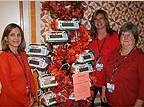
NICU nurses, left to right, Julie Murphy, Joann Fauth and NICU Nurse Manager Sue Culp took part in the Nov. 17 launch of the new system.
Nurses in the Neonatal Intensive Care Unit (NICU) at Hopkins Children’s are well aware of the human costs of so-called medical misconnections, when seemingly incompatible systems are inadvertently connected with each other. Some 60 cases in the medical literature include a hospitalized infant who suffered respiratory distress and seizures after accidentally receiving breast milk intravenously instead of through a nasogastric tube. In another case, both a pregnant mom and her fetus died after a nurse mistakenly infused tube feeding through the patient’s central catheter line.
“It doesn’t happen often,” says NICU nurse Julie Murphy, “but when it does the consequences can be catastrophic.”
The causes include human error and fatigue, inadequate training, rotating shift work and time pressures – contributing factors all cited in a 2008 medical tubing alert issued by The Joint Commission (TJC), formerly the Joint Commission on Accreditation of Healthcare Organizations. Responding to the TJC alert and the potential for serious outcomes, Murphy and fellow NICU nurse JoAnn Fauth three years ago began searching for a new system that would prevent or significantly reduce the risk of tubing misconnections. They evaluated and tested an array of enteral feeding systems, and solicited feedback from nurses in other NICUs on their experience with such systems.
“We wanted to make sure the nurses from other hospitals were happy with a particular system,” says Murphy. “On a day-to-day basis, how did the system function? And were there any supply issues?”
“We looked at everything available in the market,” adds Fauth. “Our goal was whatever system would be best for our babies.”
Finding the ideal system was not easy as the enteral feeding/infusion industry is mostly geared to the adult population. But Murphy and Fauth were able to identify a suitable enteral feeding system coupling orange color-coded tube connectors that do not fit with IV or other non-enteral tubes. Also, the system includes an oral syringe, also orange, which is incompatible with IV tubing. The nurses note they were challenged in identifying an appropriate pump that could be programmed to only accept the new enteral syringes and administer the small volume a NICU baby requires. Once the appropriate pump was in hand, it was marked “enteral” in orange letters and programmed for enteral feeding only.
“The pieces of the enteral feeding system talk to each other but not to the IV system, and the IV system in turn does not talk to the feeding system,” says Murphy. “They can’t hook up with each other, which is why this is such an exciting safety initiative.”
Hopkins Children’s NICU nurses, Murphy notes, will still trace the tubing to the point of origin before any connections or reconnections are made, recheck connections and trace all patient tubes and catheters upon transfer to a new unit, and label tubes. The initiative was launched on November 17 in the NICU, where orange was clearly the color of the day.
